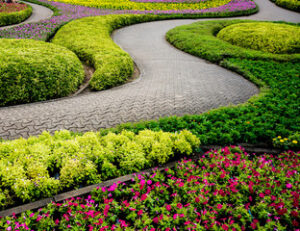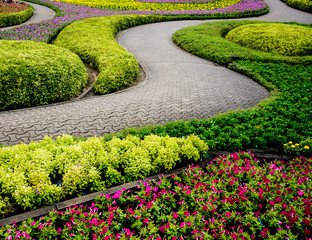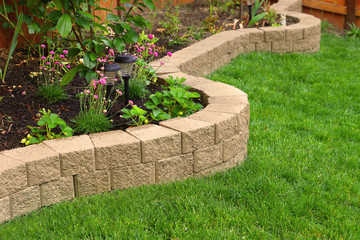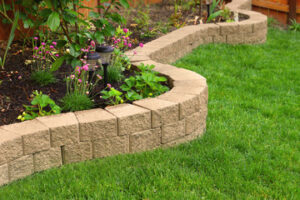Landscaping is the art of designing and maintaining outdoor spaces for beauty, utility, and enjoyment. It combines creative elements like water features, flowers and trees with hardscapes such as patios and walkways.
Consider how each element will be sized and positioned to create balance in your landscape. Pay attention to contrasting shapes, sizes and colors, and use lines to direct your eye through the garden. Contact Landscaping in Greensboro NC for professional help.
Having a home irrigation system allows for uniform distribution of water that is delivered only when and where plants need it. This type of watering minimizes salt imbalance, soil erosion, leaf burn, and reduces weeds. It also prevents run-off of nutrients and water. There are many different irrigation systems available for residential use. Each has its advantages and disadvantages depending on labor availability, capital outlay, and other factors. Regardless of which type of irrigation system you choose, it is important to properly maintain your irrigation system.
In a spray irrigation system, water is directed from a hose or sprinkler head onto a field, garden, or lawn area. This type of irrigation system can be quite inefficient as much of the water is lost to evaporation and wind drift. This method of watering is often not as good for sandy or clay soils, and it may also cause root damage to some plants.
A drip irrigation system uses a network of tubes or pipes with emitters to provide a slow and steady supply of water directly to plant roots. This type of irrigation system is more efficient as it minimizes evaporation and run-off, and can be easily modified for different types of plants and soil conditions.
This type of irrigation system is a popular choice for gardens, flower beds, and shrubbery. It is effective at preventing weed growth and soil erosion, and it can be customized to suit slopes and uneven terrain.
Another popular type of irrigation system is a center pivot irrigation system. This system is supported by a series of towers that move laterally or in a circle, providing an even spread of water across the field. This is a great option for large fields because it can cover an entire acre with one machine.
Smart irrigation systems use sensors that read weather and soil data to determine if the plants need water. Then the controller dictates which zones power on to keep your lawn and garden well hydrated with minimal waste. These systems are great for saving time and money, as well as reducing the need for manual watering.
Irrigation Pumps
Irrigation pumps draw water from a source, such as a well, tank, river or lake, and use a motor to increase pressure and generate a constant flow of water. They’re an essential part of automated irrigation systems, allowing water to be delivered precisely where it is needed by using a sprinkler or drip system.
To maximize performance, it’s important to choose a pump that is capable of handling the irrigation requirements of your property. The water pressure required for a sprinkler system depends on the size of the area being irrigated, the type of crop and the weather conditions in your area. If you’re not sure what water pressure you need for your irrigation system, speak with a professional.
The irrigation pump you need should be able to lift the water at the required height and provide enough water pressure for the entire area being irrigated. It should also be able to deliver the necessary amount of water per hour. This information will help you select the right pump.
There are several different types of irrigation pumps, including submersible and surface centrifugal. Submersible irrigation pumps are designed to operate underwater, making them ideal for drawing water from wells and other shallow water sources. Surface centrifugal pumps work well for irrigation applications that require a water supply from reservoirs, lakes and other surface-based sources.
Before you can start using your irrigation pump, it’s essential to prime it. This process involves filling the pump with water to remove air and ensure that the motor is properly lubricated. You should follow the manufacturer’s instructions for priming your pump, and always check for safety guidelines before using it.
Irrigation pumps are an affordable way to keep your lawn green and lush. Miami Pump & Supply offers a wide variety of irrigation pumps to suit your needs and budget. We’re here to help you find the right pump for your home or business irrigation system.
Irrigation Controllers
Irrigation controllers are the brains behind irrigation systems, allowing you to control your sprinkler zones via pre-programmed watering schedules. Modern irrigation controllers aren’t just traditional timers; they offer features like Wi-Fi connectivity, weather forecasts and sensors that automatically adjust the watering settings on your irrigation system to suit the specific needs of your landscaping.
In the United States alone, outdoor water use averages more than 9 billion gallons per day, with over half of that water used for landscape irrigation. Smart irrigation technology helps reduce these numbers, significantly improving outdoor water efficiencies through automated adjustments of soil conditions, weather and evaporation to match the actual requirements of your landscaping.
There are many different types of smart irrigation controllers available, and finding the right one for your needs can seem daunting at first. Some of the most common options include climatologically-based and soil moisture-based controllers.
Climatologically based irrigation controllers use an on-site sensor that measures rainfall or air temperature to determine plant watering requirements. These data are then compared to a pre-programmed ET (plant water usage) curve, and the irrigation system is instructed to irrigate at a rate that meets or exceeds the specified ET for the site.
These controllers are typically less expensive than other smart controllers, and they can be easily programmed by simply following the instructions provided with your product. Some manufacturers also offer mobile apps for easy scheduling, reducing the need for manual changes to your irrigation schedule.
A common problem with these controllers is over-watering, resulting in wet spots on the lawn and damage to the plants. In many cases, this can be caused by problems with the irrigation schedule or a faulty valve. To avoid these problems, it is recommended that homeowners follow a simple check list.
When choosing an irrigation controller, consider how many zones you will need to irrigate as well as whether you may want to expand your system in the future. This will help you select a model that can grow with your landscaping needs. You should also read the irrigation controller’s manual to learn how to program your particular model.
Irrigation Hoses
Irrigation hoses make it easy to water plants by delivering the moisture directly to plant roots. This targeted approach reduces evaporation and runoff, so you can keep your garden healthy without wasting water. Ace carries a wide selection of irrigation hoses and tubing for residential and commercial landscapes.
Soaker hoses (sometimes called soaker tubing or irrigation piping) are simple to set up and easy on the wallet. They look like regular hoses but have porous tubing that weeps water along its length when irrigated. This wets the soil down to about 6 inches below ground level, so you don’t have to worry about your plant’s foliage getting wet and inviting fungal growth.
You can buy soaker hoses for use in vegetable gardens, planters, raised beds and flower beds. They’re also ideal for hydrating shrubs and trees. Soaker hoses aren’t as effective as a sprinkler system for hydrating lawns, but they’re cheaper and more convenient than installing an in-ground sprinkler system.
Unlike sprinkler systems, soaker hoses can be used by novice gardeners and don’t require professional installation. To use a soaker hose, simply attach it to a faucet, snake it through the garden and around plants or trees you want to hydrate. For best results, cover the hose with mulch to prevent sunlight from warming and drying the soil. If you have trouble remembering to shut off the hose, invest in a hose timer to prevent overwatering.
For a more efficient hydration system, you can add emitter drip tubing to your soaker hoses. These tubes have pre-punched holes at regular intervals that deliver uniform watering. This type of hydration system is great for flower beds, vegetable gardens and orchards and can be found at your local Ace.
If you’re not sure whether a soaker hose or an emitter drip tube will be more effective for your gardening needs, try this experiment: Place a container in the garden and turn on your irrigation hose. Measure how long it takes for the container to fill one inch. Then, divide this number by the average weekly watering recommended for your plants.


